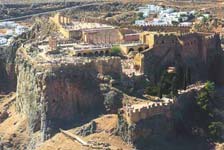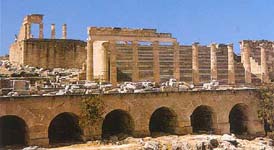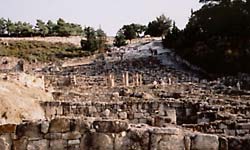|
Acropolis of Rodos and the Acient Stadium.
The hill overlooking the modem new town and Mediaeval town
is the site of the ancient Hellenistic town of Rodos and the Acropolis
of Rodos. In antiquity the population of the city was many times
larger than that of today and extended over the eastern slopes of
Agios Stephanos (latterly known as Monte Smith after the English
admiral Sir Sidney Smith who established an observation post in 1802
to watch over the movements of the Napoleonic fleet in 1802) right
down to the harbour. On the Acropolis are the remains of the Temples
of Zeus and Athena and the partly-restored Temple of Apollo, then, as
now, a landmark for ships at sea.
Below is the heavily-restored Stadium which is still used for
occasional performances of classical tragedies. Visit at sunset to
watch the spectacular sunset. |
|
|
 |
|
Acropolis of
Lindos.
 This rock, which rises to 116 m. forms the finishing touch to the
landscape of Lindos, standing dry and imposing in its bareness and
surrounded on all sides by the sea, so that Lindos may rejoice in the
ocean in the words of a Hellenistic epigram. Lindos does not seem to
have been particularly important in the earlier periods, though
sporadic finds of the Neolithic period and the Bronze Age have been
discovered on the acropolis. This rock, which rises to 116 m. forms the finishing touch to the
landscape of Lindos, standing dry and imposing in its bareness and
surrounded on all sides by the sea, so that Lindos may rejoice in the
ocean in the words of a Hellenistic epigram. Lindos does not seem to
have been particularly important in the earlier periods, though
sporadic finds of the Neolithic period and the Bronze Age have been
discovered on the acropolis.
According to legend, the foundation of the sanctuary of Athena Lindia
goes back to the Mycenaean period, and Mycenaean finds have been
yielded by cemeteries in the broader area of Lindos. The Archaic
period (7th-6th c BC) was a golden age for Lindos, which played a
leading role in the Greek colonisation movement, its most important
foundation being Gela in Sicily. The 6th c BC was dominated by the
figure of a moderate tyrant, Kleoboulos who ruled Lindos for many
years, and was Included amongst the seven sages of the ancient world.
During his rule, the Archaic temple of Athena was built on the site of
an earlier structure, and the acropolis received its first monumental
form. The Persian advance and later the merger of the three old cities
into the new city of Rodos (408 BC) led to a diminution in the
importance of Lindos as a political and economic power.
It nevertheless continue to be an important centre, focused on the
famous sanctuary of Athena, which received its final monumental form
in the Hellenistic period and became the leading sanctuary on the
island. The acropolis was used as a fortress in antiquity, as well as
In Byzantine times, in the period of the Knights of St. John, and in
that of Ottoman rule. |
| |
|
Ialysos and the mount
Filerimos
Ialysos is one of the three ancient cities of Rodos with remains of
occupation dating back to 3rd millennium BC and also settlements &
cemeteries dating from the Mycenaean-Minoan period.
The building remains of ancient Ialysos discovered to date are mainly
on the Filerimo hill , which was given this name in Byzantine times.
Its earliest known name was Achaia, which is further evidence for the
presence of Greeks in this area during the Mycenaean period, Strabo
calls the hill Ochyroma ("Fortification"). |

 |
|
Acient Kamiros
Homer describes it as "arginoeis", a reference to its fertile,
argillaceous soil. The earliest traces of occupation in the broader
area of Kamiros, the Kamiros, go back to Mycenaean times, as is
demonstrated by the cemetery discovered at the village of Kalavarda.
Geometric and Archaic Kamiros are known manly from cemeteries, located
around the ancient city. The cemetery at Makry Langoni has yielded the
stele of Krito and Timarista, a famous piece of Classical sculpture,
now on display in the Rodos Museum.
In the area of the archaeological site that is open to visitors are
preserved the ruins of the Hellenistic city of Kamiros, which was
rebuilt after a devastating earthquake in 226 BC. There had been a
settlement on this same site from as early as the Archaic period. The
city is a characteristic example of Hellenistic urban layout and
desing, with its division into zones of pubic and private buildings,
its arrangement around the natural slopes of the hill, and its
chess-board system of streets, Kamiros was divided into three unequal
parts: the lowest level which ch formed a kind of agora, with a
religious character, a zone with private dwellings on the side of the
hill, the acropolis on the summit. At the north-west edge of the Agora
Square stand the restored columns of a Doric temple, with two columns
in antis, which dates from the late 3rd-early 2nd c. BC. It was
possibly dedicated to the god Apollo. |
|
|